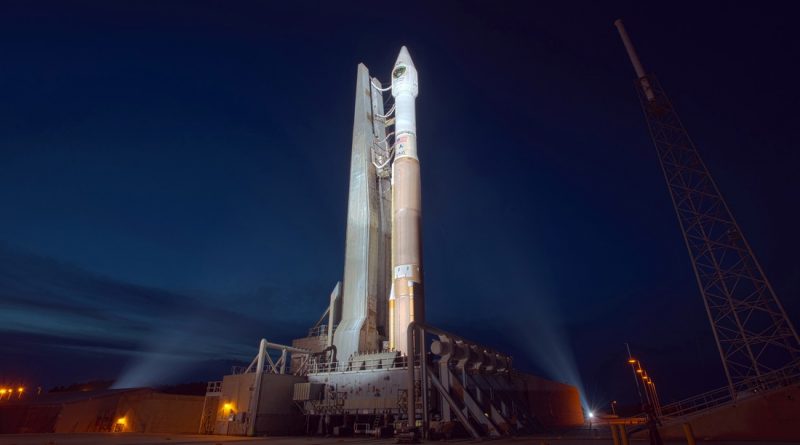Final GPS IIF Satellite to ride into Orbit in Year-Opening Atlas V Launch
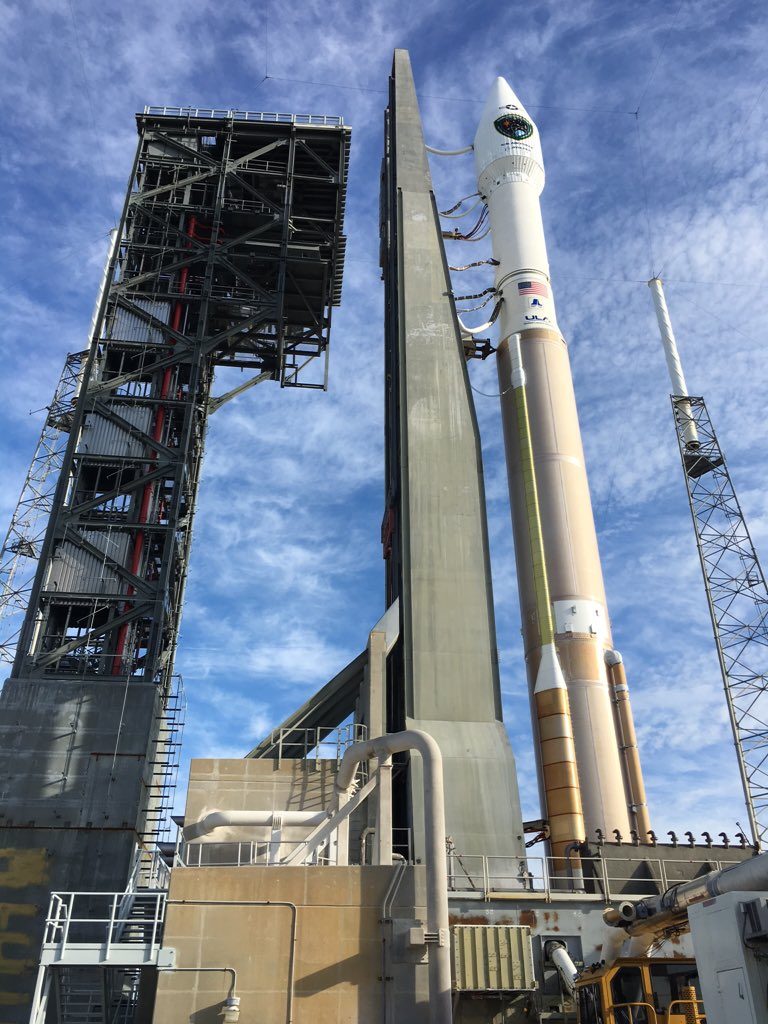
A United Launch Alliance Atlas V rocket is at the launch pad at Cape Canaveral Air Force Station for a Friday morning liftoff with the GPS IIF12 satellite to complete the deployment of a dozen GPS Block IIF satellites in the continued replenishment and modernization of the GPS satellite constellation that currently hosts 30 active spacecraft. Liftoff from Space Launch Complex 41 is planned for a 19-minute window opening at 13:38 UTC and Atlas V will be tasked with a three-hour and 23-minute mission to an orbit over 20,000 Kilometers in altitude.
This launch opens a very busy year for United Launch Alliance with as many as 15 launches on the books for 2016 for a wide customer base ranging from NASA, the U.S. military and the National Reconnaissance Office to commercial satellite operators. ULA’s 2016 manifest includes launches of the Atlas V and Delta IV launch vehicle families from both coasts of the United States, aiming to continue a trend of a steadily increasing launch rate.
GPS IIF12 is the final of the twelve Boeing-built GPS Block IIF satellites to enter orbit, marking the conclusion of one of the most aggressive deployment schedules with eight GPS IIF satellite launches in a period of two years. The Block IIF satellites introduce additional navigation signals, a higher accuracy, longer operational in-orbit lives and improved security. Each of the satellites has a mass of 1,630 Kilograms and equipped with two high-stability Rubidium clocks and a single Caesium atomic clock to provide accurate navigation signals. The first IIF satellite went into orbit back in 2010.
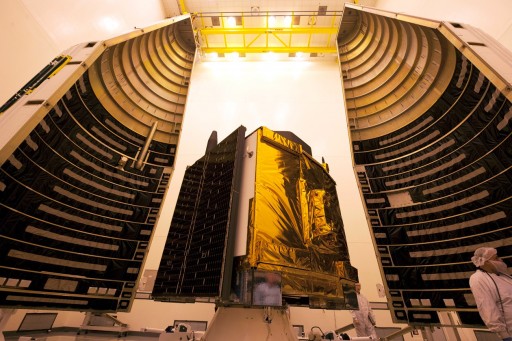
The IIF12 satellite aims for Plane F of the GPS constellation where it will enter Slot 1 to replace the IIR-6 satellite that was launched back in late 2000 and looks forward to taking a different spot in the constellation from where it will enhance legacy coverage and serve a redundant function. Coinciding with the deployment of the satellite, the GPS program is retiring its oldest satellite, GPS IIA-10 launched in 1990.
Plane F was chosen for the last GPS IIF satellite to optimize the coverage of modernized GPS signals that offer a greater accuracy to users. With all GPS IIF satellites taking their spot in orbit, the program can look forward to some downtime in terms of satellite deployments. GPS IIIA, the next generation of GPS spacecraft, built by Lockheed Martin, is currently expected to begin deployment in 2017. The IIIA satellites will continue the incremental improvement of the GPS constellation as aging satellites are replaced with newer, more capable craft.
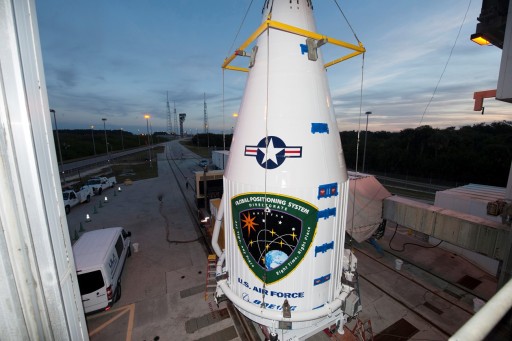
GPS IIF-12 was delivered to Florida’s Space Coast back in October to begin its final processing campaign filled with testing of the satellite, propellant loading and eventually the installation atop the payload adapter and inside the fairing. The Atlas V rocket was stacked in the first half of January as the RD-180-powered Common Core Booster took its place atop the Mobile Launch Platform and had its Centaur Upper Stage installed to mark the start of testing activities. GPS IIF12 was installed atop its ride to space on Saturday.
GPS IIF12 was the final satellite to be processed for launch at Cape Canaveral’s Navstar Processing Facility where, for 27 years, a total of 61 satellites were readied for launch. With the inauguration of GPS IIIA next year, processing is shifted to the off-site Astrotech facility in Titusville where most satellites launching from Florida pass through on their way to the pad. Area 59 at CCAFS does not currently have a future user and evaluations of options are currently underway to work out what is to be done with the facility.
The launch of GPS IIF12 was delayed two days last week as additional time was needed for checks of electrical connectors on the launch vehicle. Wednesday’s Launch Readiness Review cleared the rocket for liftoff as no problems were found on the launch vehicle, the satellite and ground support systems.
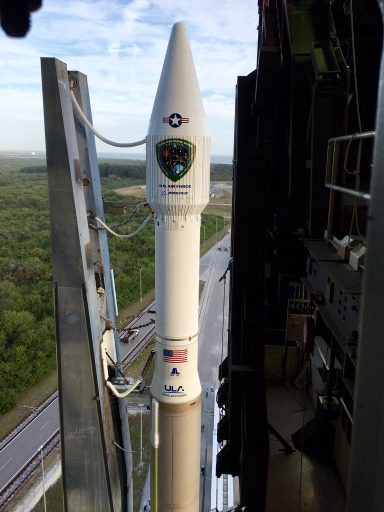
The 58-meter tall Atlas V workhorse emerged from the Vehicle Integration Facility in the early morning on Thursday, sitting atop its Mobile Launch Platform for a 30-minute ride to the pad. Carefully centered on the pad, the MLP will be connected to ground systems for the delivery of propellants, power, gas supply and data connectivity during the final preparations for the countdown. The trackmobiles used to move the MLP will be pulled free later on and teams will begin closing out the rocket and ground systems for countdown operations, starting seven hours prior to the expected T-0 time.
Weather for Friday’s launch attempt holds the potential of coming into the way of an on-time liftoff of the Atlas V rocket. Odds of acceptable weather during the 19-minute launch window are only 40% with primary concerns being high ground winds and violations of the thick cloud rule. Cape Canaveral is currently under the influence of a cold front bringing showers and thunderstorms along with winds gusting to 28KT. Winds are expected to trend down throughout the day on Friday and meteorologists have issued an 80% chance of good weather for the backup slot on Saturday with Cumulus Clouds being the primary concern.
.
Countdown & Launch Preview
Ahead of the countdown, technicians will already be busy at the pad, completing final hands-on work and closing out the Atlas V Integration Facility, pad facilities and the Atlas V launcher. The first step completed at T-6 Hours 20 Minutes is the activation of the Atlas V rocket.
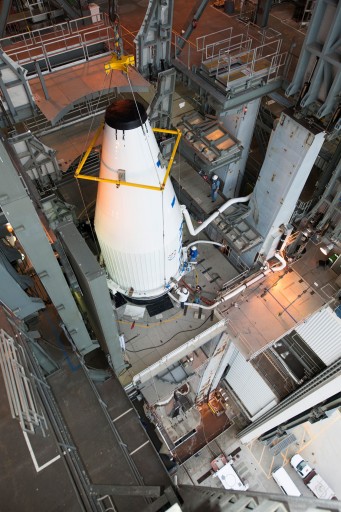
The Atlas V 401 is the most basic and most-flown version of the Atlas V rocket. It uses the Common Core Booster as first stage with the trusted Centaur serving as upper stage. The vehicle stands 58.3 meters tall, is 3.81 meters in diameter and weighs 334,500 Kilograms at liftoff. No solid rocket motors are employed on this version of Atlas V. Atlas V 401 is topped by the short version of the 4-meter fairing.
Following the activation of the launcher, teams begin a series of checkouts of the electrical system of the rocket. Meanwhile, at the launch pad, technicians complete final hands-on work.
While that is in progress, the Launch Team puts the Atlas V through a series of communication checks on its S- and C-Band Systems.
Flight Termination System testing is also completed and the Nitrogen Purge flow on the vehicle is initiated. L-4 Hour commanding is performed by teams and by L-3 hours, the launch pad is cleared by all personnel.
At T-2 Hours, the countdown enters a 30-minute built-in hold during which teams perform the fueling pre-task briefing and the GO/No GO Poll for propellant loading. As soon as the countdown resumes at T-2 Hours, propellant loading operations start. The complex procedure to load the two stages of the rocket with cryogenics begins with the chilldown of ground support equipment, transfer lines and tanks chilldown on the Liquid Oxygen side. Liquid Oxygen starts flowing into the Centaur upper stage tanks shortly thereafter. Centaur LOX loading takes about 40 minutes as 15,700 liters of –183-degree Celsius oxidizer are filled into the upper stage.
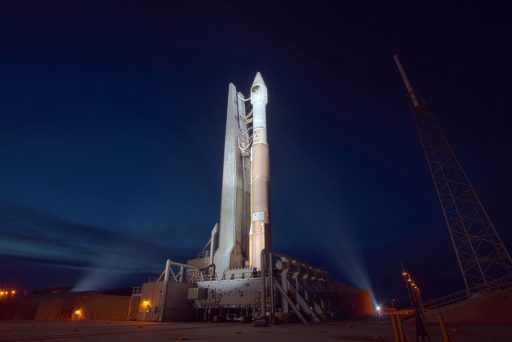
Once Centaur is into propellant loading, the large Liquid Oxygen tank of the Common Core Booster also starts fueling. LOX load on the CCB also moves through the three steps, slow-fill, fast-fill and topping. The Common Core Booster is loaded with Rocket Propellant 1 (refined Kerosene) ahead of the launch countdown. The large Common Core Booster that stands 32.46 meters tall with a diameter of 3.81m and a fuel load of 185,500 liters of LOX and 94,600 liters of RP-1.
The final tank to be loaded during the countdown is the Liquid Hydrogen Tank of the upper stage that also goes through the usual steps. Centaur is loaded with a total of 48,100 liters of -253-degree Celsius LH2 fuel. The Centaur stage is 12.68 meters tall and 3.05 meters in diameter with over 200 previous missions under its belt. When clocks reach T-4 Minutes, the countdown enters its final built-in hold. This hold can be extended in case of technical issues or uncooperative weather, but the window for GPS IIF-11 is relatively short with a duration of 19 minutes. During the hold, the launch team receives a final weather briefing and performs the GO/No GO Poll for the Terminal Countdown.
As clocks start ticking down from T-4 Minutes, final vehicle configurations such as ordnance arming, flight termination system arming, propellant tank pressurization, transfer to internal power, and flight control system reconfigurations will be made as part of the Automated Sequence to place the vehicle in its launch configuration.
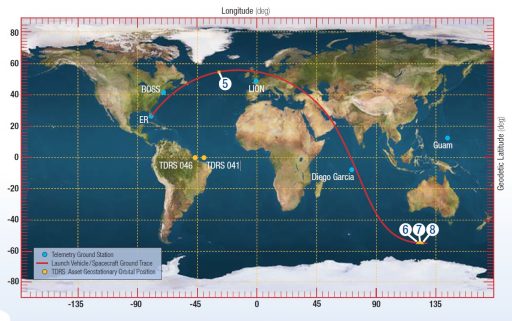
At T-2.7 seconds, the massive two-chamber RD-180 main engine of the Common Core Booster ignites and soars up to its full liftoff thrust of 390,250 Kilograms. Engine start-up is closely monitored by flight computers to make sure it reaches operational conditions before the launcher is committed to flight. As clocks hit zero, the hold-down system releases the launcher and Atlas V blasts off.
Without any Solid Rocket Boosters, the Atlas V 401 makes a relatively slow initial ascent with a Thrust to Weight Ratio of 1.16.
After ascending vertically for 17 seconds, the Atlas V will begin its pitch and roll maneuver to align itself with its pre-determined flight path, departing Florida’s Space Coast to the north-east.
After 78 seconds, the rocket passes Mach 1 followed by Maximum Dynamic Pressure about 12 seconds later. As the first stage approaches the 4-minute mark into the flight, it will start throttling down its RD-180 engine to maintain a maximum acceleration of 5 Gs. During first stage flight, the Centaur Upper Stage initiates Reaction Control System pressurization and boost-phase chilldown.
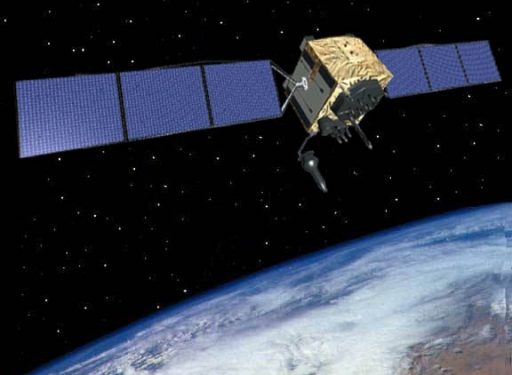
Just after passing the four-minute mark, the first stage will shut down its RD-180 engine. At T+4:10, six seconds after shutdown, pyrotechnics will be fired to separate the Common Core Booster that then uses eight small solid rocket motors to move away from the Centaur upper stage.
At T+4:20, the RL-10C engine of the Centaur Upper Stage will ignite on its first of two burns. This 12-minute and 44-second burn delivers the stack into an elliptical Parking Orbit around Earth for a coast phase. The orbit is targeting an apogee at GPS altitude so that the long coast will allow the stack to climb up to apogee for the second burn to act as circularization maneuver and inject the payload in the GPS orbit. The long coast is planned to be just over three hours in duration.
During the coast phase, the stack performs a PTC Roll to evenly distribute sun exposure on the vehicle and Centaur performs regular RCS thermal conditioning firings. In its parking orbit, the stack will make a pass over Europe, the Middle East and the Indian Ocean before reaching the correct position for the burn south of Australia.
The Centaur Upper Stage will begin its second burn at T+3 hours 17 minutes and 4 seconds. The RL-10 engine will burn for one minute and 27 seconds to raise the perigee and achieve a circular orbit at 20,459 Kilometers in altitude and an inclination of 55 degrees. Following Centaur engine cutoff, the stack will maneuver to the correct attitude to send GPS-IIF12 on its way at T+3:23:16. The Centaur upper stage completes a Collision and Contamination Avoidance maneuver and undergoes passivation to conclude its mission.

